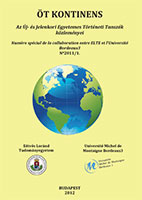Historical Films as Tools of Communist Propaganda. Contribution to the History of the Czechoslovak Cinematography at the Turn of the 1940s and 1950s
Historical Films as Tools of Communist Propaganda. Contribution to the Histoty of the Czechoslovak Cinematography at the turn of the 1940s and 1950s
Author(s): Martin KovářSubject(s): History
Published by: Eötvös Loránd Tudományegyetem, Új-és Jelenkori Egyetemes Történeti Tanszék
Keywords: Communist Czechoslovakia; Nationalized Cinematography; Communist Ideology and Propaganda; Otakar Vávra; Hussite Movement; "Hussite Trilogy"
Summary/Abstract: The historical films became the important tools of the Communist propaganda and strengthen the position of the Communiste Party. In the years 1954 - 1956 the Czech director Otakar Vávra presented in his grandiose and very expensive movies, so called "Hussite Trilogy", to the fascinated people not only the picture of the national heroes fighting against "German aggressors" from the 15th century (obvious analogy with the struggle against Germans during the Second World War), but, at the same time and mainly, the fact that the Czech and Slovak "common (or ordinary) people", the predecessors of the future Communists, raised up against the German aristocratcy and against the corrupted Catholic Church already many centuries ago. His works are, according to many experts, the best example of the Communist propaganda in the big screen during the first phase of the Communiste rule in this country.
Journal: ÖT KONTINENS
- Issue Year: 2011
- Issue No: 1
- Page Range: 177 - 186
- Page Count: 10
- Language: English

